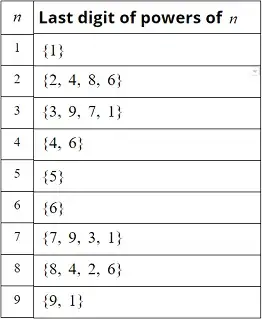Assuming that the $n$th step moves the ball $n^n$ places around the circle, we need to find the integer $x$ such that $0 \leq x < 10$ and
$$
\sum_{n=1}^{2020} n^n \equiv x \pmod{10}.
$$
Note that $$\sum_{n=1}^{2020} n^n \equiv \sum_{n=1}^{2020} a_n \pmod{10},$$
where $0 \leq a_n < 10$ and $n^n \equiv a_n$ for each $n,$
and that $n^n \equiv m^n \pmod{10}$ if $n \equiv m \pmod{10}.$
Also observe the following for any integer $k$:
\begin{align}
3^4 \equiv 7^4 \equiv 9^2 &\equiv 1 \pmod{10}, \\
2^4 \equiv 4^2 \equiv 8^4 &\equiv 6 \pmod{10}, \\
6^k &\equiv 6 \pmod{10}, \\
5^k &\equiv 5 \pmod{10}.
\end{align}
The first $20$ terms of the series have the following equivalences:
\begin{align}
1^1 &\equiv 1 \pmod{10}, \\
2^2 &\equiv 4 \pmod{10}, \\
3^3 &\equiv 7 \pmod{10}, \\
4^4 &\equiv 6 \pmod{10}, \\
5^5 &\equiv 5 \pmod{10}, \\
6^6 &\equiv 6 \pmod{10}, \\
7^7 \equiv (-3)^7 &\equiv 3 \pmod{10}, \\
8^8 \equiv (-2)^8 &\equiv 6 \pmod{10}, \\
9^9 \equiv (-1)^9 &\equiv 9 \pmod{10}, \\
10^{10} \equiv 0^{10} &\equiv 0 \pmod{10}, \\
11^{11} \equiv 1^{11} &\equiv 1 \pmod{10}, \\
12^{12} \equiv 2^{12} &\equiv 6 \pmod{10}, \\
13^{13} \equiv 3^{13} &\equiv 3 \pmod{10}, \\
14^{14} \equiv 4^{14} &\equiv 6 \pmod{10}, \\
15^{15} \equiv 5^{15} &\equiv 5 \pmod{10}, \\
16^{16} \equiv 6^{16} &\equiv 6 \pmod{10}, \\
17^{17} \equiv (-3)^{17} &\equiv 7 \pmod{10}, \\
18^{18} \equiv (-2)^{18} &\equiv 4 \pmod{10}, \\
19^{19} \equiv (-1)^{19} &\equiv 9 \pmod{10}, \\
20^{20} \equiv 0^{20} &\equiv 0 \pmod{10}.
\end{align}
That is, $a_1 = a_{11} = 1,$ $a_2 = a_{18} = 4,$
$a_3 = a_{17} = 7,$ $a_4 = a_6 = a_8 = a_{12} = a_{14} = a_{16} = 6,$
$a_5 = a_{15} = 5,$ $a_7 = a_{13} = 3,$ $a_9 = a_{19} = 9,$
and $a_{10} = a_{20} = 0.$
Also note that for any integer $n$ such that $1 \leq n \leq 20$
and any non-negative integer $k,$
$$ (n + 20k)^{n+20k} \equiv n^{n+20k} \equiv n^n \pmod{10}. $$
For $n = 10$ or $20$ this follows since
$(n + 20k)^{n+20k} \equiv 0^{n+20k} \equiv 0 \pmod{10};$
for $n = 5$ or $15$ because
$(n + 20k)^{n+20k} \equiv 5^{n+20k} \equiv 5 \pmod{10};$
for $n = 2$ or $18$ because
$(n + 20k)^{n+20k} \equiv n^n n^{20k} \equiv 4 n^{20k} \pmod{10}$
and because $n^{20k} \equiv 6 \pmod{10};$
for $n = 4,6,8,12,14$ or $16$ because
$(n + 20k)^{n+20k} \equiv n^n n^{20k} \equiv 6 n^{20k} \pmod{10}$
and because $n^{20k} \equiv 6 \pmod{10};$
and for $n = 1,3,7,9,11,13,17$ or $19$ because
$(n + 20k)^{n+20k} \equiv n^n n^{20k} \pmod{10}$
and because $n^{20k} \equiv 1 \pmod{10}.$
The terms $a_n$ therefore repeat in a cycle of length $20,$ so
$$ \sum_{n=1}^{2020} a_n = 101 \sum_{n=1}^{20} a_n = 101 \times 94
\equiv 4 \pmod{10}.$$
